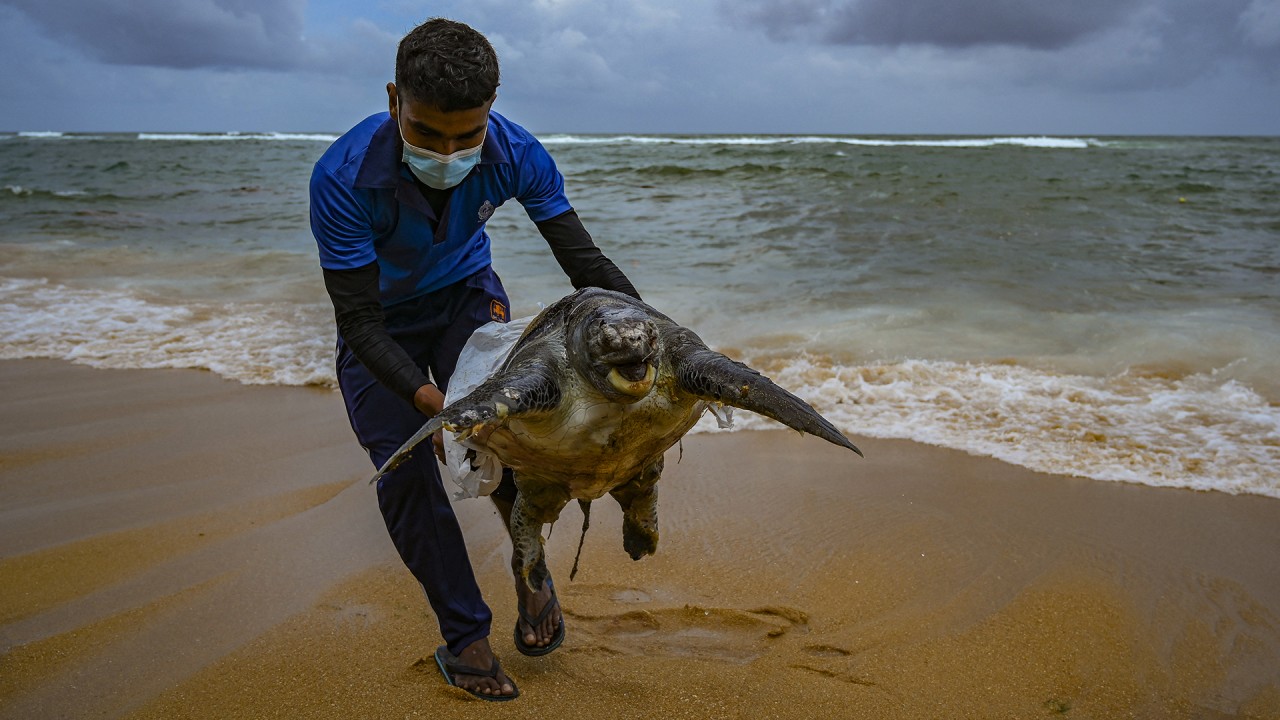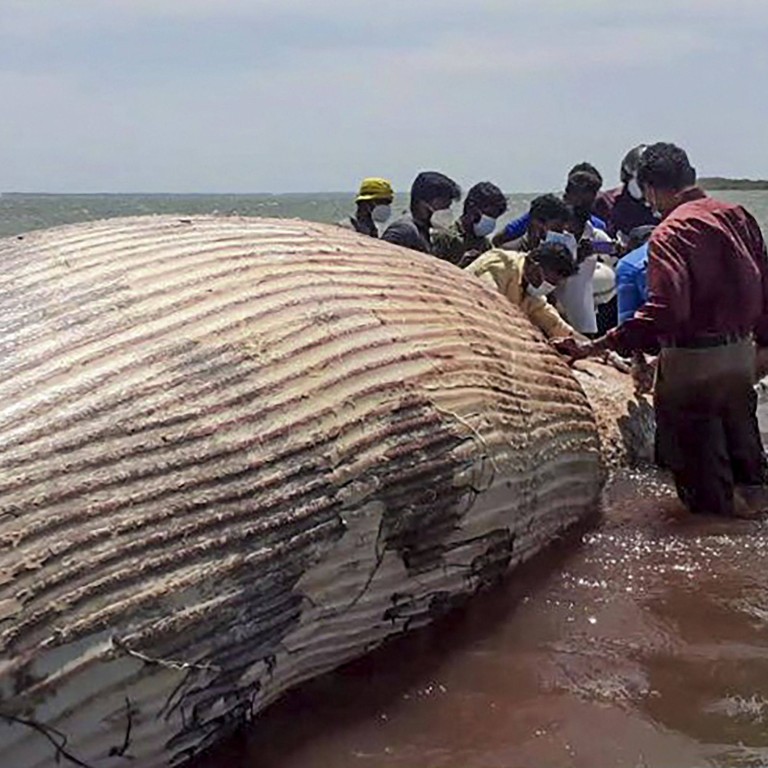
Sri Lanka waits on compensation, answers from Singapore-registered X-Press Pearl disaster 18 months after vessel sank
- The ship caught fire and sank off Sri Lanka, with plastic pellets, nitric acid and fuel among the many harmful substances released into the ocean
- Hundreds of creatures died, including whales. Fishermen are still finding plastic in fish, but there’s been little compensation so far
The Singapore-registered vessel, carrying hazardous chemicals and plastic pellets, caught fire off Sri Lanka’s west coast in May last year, apparently because of a nitric acid leak. All 25 crew were evacuated, with two suffering minor injuries.
On November 25, five people, including the captain and the local agent, were handed indictments under the nation’s Marine Pollution Prevention Act, released on bail and banned from travelling overseas.
State Minister of Urban Development and Housing Arundika Fernando told parliament last week that an interim report had been handed to Australian legal advisers and he hoped ultimately the nation would receive US$3-4 billion in compensation, with some experts expecting more. But it is far from clear when it will come.
The ship, which was about 9.5 miles off Sri Lanka’s western coast when it caught fire, eventually sank after burning for days. In the process it spilled 25 metric tonnes of nitric acid, which is highly corrosive, and a large volume of plastic pellets.
Carcasses of dead animals, some with burn marks, began washing ashore and by July last year, the hideous tally stood at 417 turtles, eight whales and 48 dolphins.
At least one report said the ocean was contaminated with fuel as well as chemicals from the ship. In September last year, a minor daily leak of less than 20 litres of fuel was reported.
In the weeks after the disaster, debris was found on many Sri Lankan beaches, from Mannar in the northwest to Hambantota in the south, which are more than 300 miles apart. In an interview with Channel NewsAsia last year, Shmuel Yoskovitz, the boss of X-Press Feeders, the ship’s operator, apologised for the tragedy.
Sri Lanka’s Minister of Foreign Affairs, Ali Sabry, on November 24 had said the catastrophe was “considered the largest ship disaster involving plastic pellets, hazardous and noxious materials in the world. The geographic bounding of the incident remains unknown given its developing nature”.
A “substantial proportion” of the plastic pellet pollution would “remain mobilised in the ocean for decades to come”, he said, speaking at the 22nd Indian Ocean Rim Association (IORA) Council of Ministers meeting in Bangladesh.
Many of Sri Lanka’s experts and activists, though, are calling for the government to provide far more detailed information.
“We are still waiting for them to make public reports on the testing conducted on animals that beached,” said Muditha Katuwawala, coordinator of the Pearl Protectors, a volunteer organisation dedicated to looking after the environment.
Searching for truth
A study published in the ACS Environmental Au journal this year noted that during the fire, the pellets, also known as nurdles, were exposed to “carcinogenic combustion products”, potentially making them carriers of carcinogens and other pollutants.
Another report, by the International Pollutants Elimination Network and the Centre for Environmental Justice, a Colombo NGO, said the ship was carrying 348 tonnes of fuel, 9,700 tonnes of epoxy resin (a kind of plastic) and 81 containers of dangerous goods, including 210 tonnes of methanol. This was all in addition to the pellets and nitric acid.
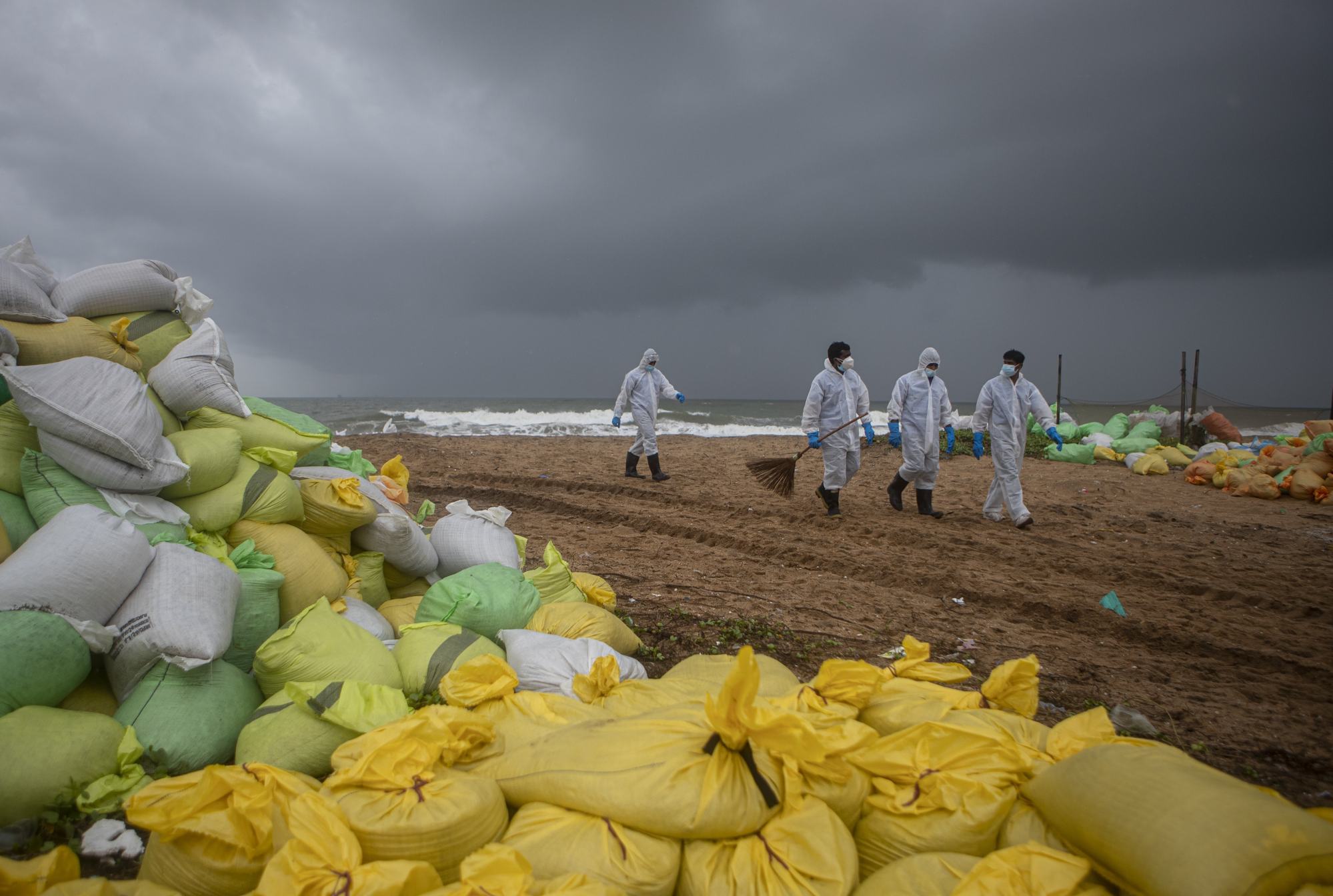
The study, released this year, stated that due to complex chemical reactions during the blaze, metals like copper, lead and mercury were detected in burned pellet lumps. They also carried traces of various carcinogens including polycyclic aromatic hydrocarbons (PAHs), some in serious risk concentrations, and other toxins like benzotriazole UV stabilisers, used in some paints and coatings to prevent light-induced degradation.
“People need to know what is actually going on, in terms of environmental costs. [Government agencies] should make their [findings] public,” Katuwawala said.
The ACS Environmental Au report also said delays in removing the ship’s wreckage would have “significant potential for further impacts”. Salvage operations are still taking place.
“I have come across nurdles that are yellow, red, gold, blue, grey and black. Some are half burned and clustered together like clouds,” he said.
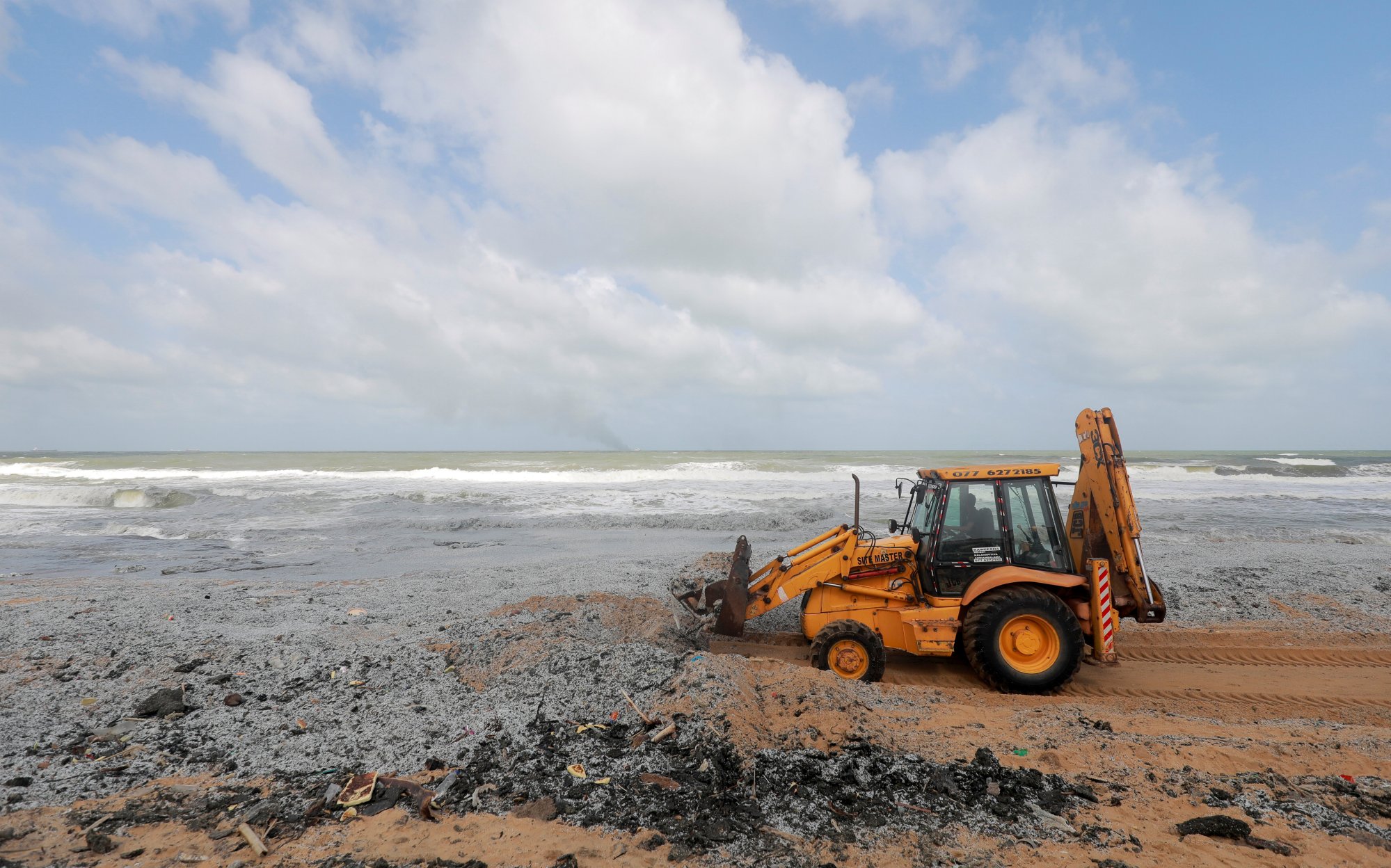
Katuwawala’s volunteers have been collecting nurdles almost every weekend since July 2021. So far, 2,600 people have been involved, picking up around 1.6 tonnes of pellets. On November 27 “we collected 23kg … from Negombo [beach]”, he said.
Nurdles are now spread over a large area of the country. Katuwawala recently spotted them in Batticaloa, on the east coast, around 200 miles from the western beaches. Monsoons also make the problem complicated, with more pellets appearing after their occurrence.
Minister Fernando recently said that almost 5,000 fishing jobs in the nation’s Western Province were affected in the immediate aftermath of the disaster. They are still being affected now.
“A few weeks ago, some fishermen on the west coast told us that one out of five fish they catch in shallow water has either nurdles or [other] plastic debris inside. We have even observed crow faeces with nurdles in them,” Katuwawala said.
‘A pittance’
So far Sri Lanka has received a little over US$7 million for interim claims from the ship’s insurer, which is based in London. However, legal experts say this is a “pittance” considering the damage.
“Insurance of this nature expands to US$10 billion, and [Sri Lanka can] claim at least US$5 billion,” said lawyer Ravindranath Dabare, chairman of the nation’s Centre for Equality and Justice.
While liability does not lie with Singapore in this instance, Sri Lanka can litigate in London where the insurer is based, said Dan Malika Gunasekera, an expert in maritime law. “The first [legal] claim should be lodged within three years,” he said.
“As the flag state, Singapore had a duty to cooperate with Sri Lanka” to determine whether the vessel was “unseaworthy at the time of entering the waters of Sri Lanka”, especially given that the “master of the ship was aware of leaking containers at the time”, he added.
But after more than 18 months, Sri Lanka’s government has failed to estimate the true cost of the damage caused to the environment and to industries like fishing and tourism, Dabare said. And that is a massive problem, with legal and financial ramifications.
“When the calculation of the damage process is delayed then the [government] cannot institute [its] claim within the [stipulated] two-year time period [in Sri Lanka’s courts].”
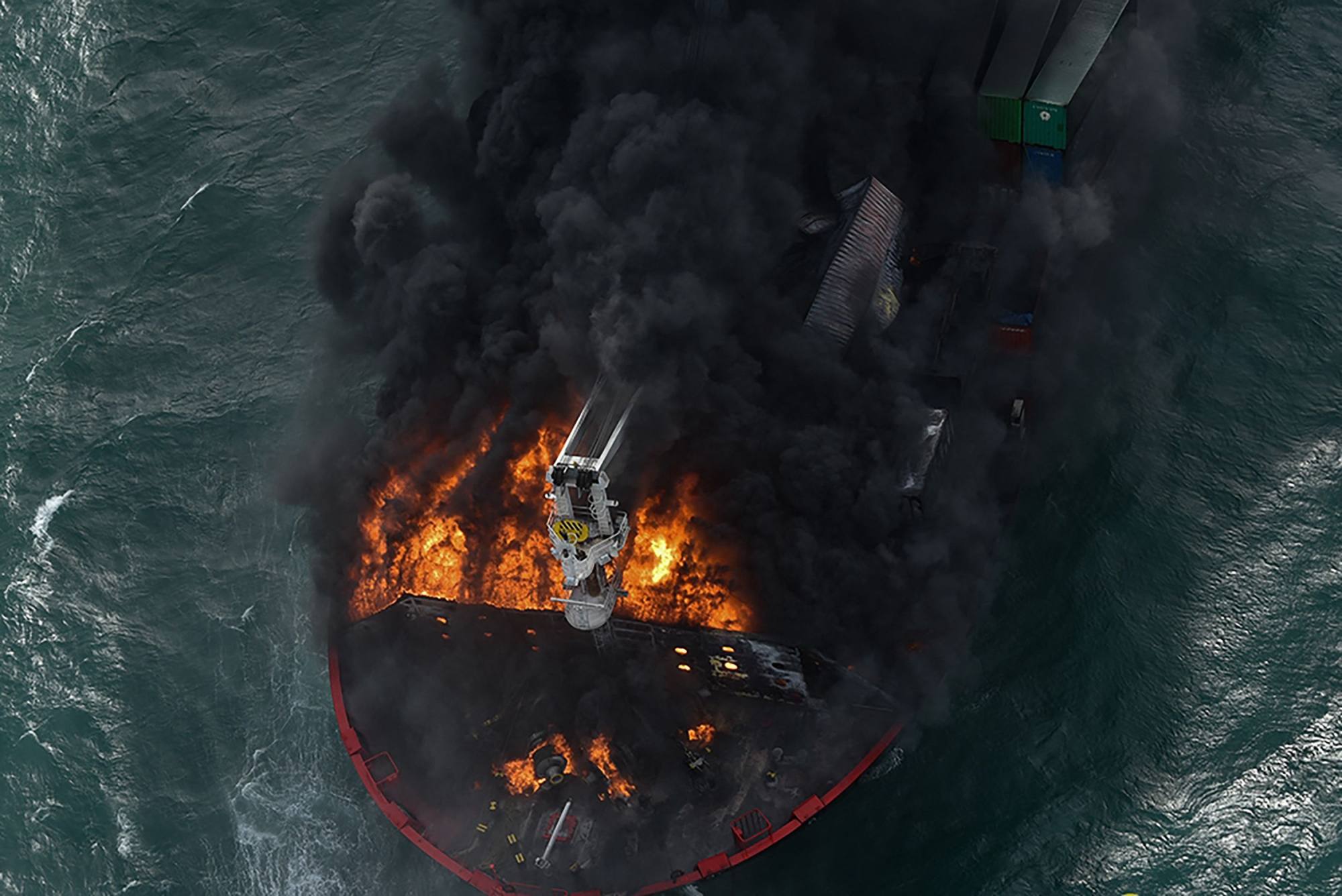
Dabare, with several others, filed a petition in June last year against the Sri Lankan president, government agencies and the owner and operator of the ship, citing environmental and health damage and livelihood losses.
The window to apply for further compensation under Sri Lankan law ends in May but the attorney general’s department said in recent days that it was still waiting for the nation’s Marine Environment Protection Authority (MEPA) to provide the evidence needed to take “further legal steps”.
Dharshani Lahandapura, MEPA chair, said most of the laboratory and postmortem reports on the dead animals had been received and were being added to compensation applications, following discussions with Australian legal advisers.
“The [reports] will definitely be published after we finalise the claim and take the required legal action,” she said.
Meanwhile, Pearl Protectors continue their clean-up operations but to remain safe from harmful substances lurking on their beaches, they insist all volunteers wear gloves and nobody walks barefoot.
As Katuwawala said, “We have to do something [for the environment], but at the same time we take precautions so that we are not affected by the [chemicals in] these nurdles.”


